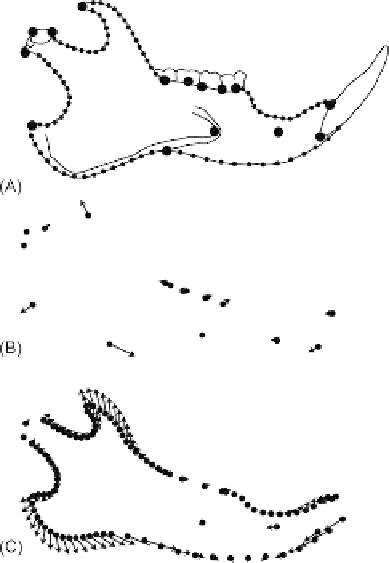Biology Reference
In-Depth Information
displacements are meaningful in only one direction (along the length of the defining seg-
ment). For example, a Type 3 landmark could be defined as the point furthest away from
some structure (e.g. the hypoglossal foramen) in the direction parallel to the skull midline
axis. That point has only one real coordinate (the other is fixed by the definition of the
landmark) so the only meaningful displacements of the point are in the direction of the
one free coordinate. Semilandmarks are similarly deficient, having only one meaningful
direction of change because any variation in their position along the curve is arbitrary.
This classification discourages the use of both Type 2 landmarks and semilandmarks but,
in our experience, Type 2 landmarks are at least as valuable as Type 1 for developmental and
biomechanical studies. Landmarks along the boundary of a growing structure, which are
often Type 2, may even provide most of the information available about developmental pro-
cesses when growth occurs by deposition at the margins (i.e. by processes such as periosteal
growth). Type 1 landmarks that are surrounded by tissue get trapped in the growing extracel-
lular matrix and may therefore be nearly invariant in their position
their displacements are
due to growth happening elsewhere. Landmarks along the periphery are the ones that record
the changes in proportion caused by bone deposition. Biomechanical studies similarly benefit
from information about the locations where the forces are applied. The explanations sup-
ported by Type 2 landmarks may not be as elegant as accounts of deformations, but to serve a
useful explanatory role, landmarks should provide a rich description of the effects of a pro-
cess. They should covary with the process and inform us about its effects on shape. That Type
2 landmarks and semilandmarks serve that purpose should be evident in
Figure 2.7
,which
FIGURE 2.7
Ontogenetic shape change of the mandible
of a ground squirrel, Spermophilus beecheyi. (A) Landmark
and semilandmark measurement scheme (the larger dots
are the landmarks); (B) ontogenetic change described by
landmarks alone; (C) ontogenetic change described by land-
marks, supplemented by semilandmarks.



